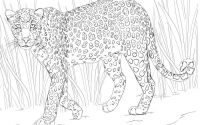Carboniferous Era Animals Coloring Pages
Creating Coloring Page Designs

Carboniferous era animals coloring pages – This section details the design concepts for three Carboniferous-era animal coloring pages, each employing a different artistic approach to cater to various skill levels and preferences. The aim is to provide engaging and educational activities that accurately represent these fascinating prehistoric creatures.
Carboniferous Animal Coloring Page Designs, Carboniferous era animals coloring pages
The following table Artikels three distinct coloring page designs, each featuring a different Carboniferous animal. The designs range from simple Artikels suitable for younger children to more detailed anatomical drawings for older children and adults. Each design incorporates key features of the animal to enhance learning.
| Animal Name | Description | Design Style | Notable Features |
|---|---|---|---|
| Meganeura (Giant Dragonfly) | This coloring page features a large dragonfly with a wingspan of up to 70 cm. Its body is elongated with a slender abdomen and large, intricately veined wings. The head has large, multifaceted eyes. | Simple Design | Large wingspan, prominent eyes, elongated body, detailed wing venation (simplified for coloring). The simple design emphasizes the overall shape and size of the insect. |
| Arthropleura (Giant Millipede) | This coloring page presents a detailed anatomical drawing of Arthropleura, a giant millipede that could reach lengths of up to 2.5 meters. The design shows its segmented body, numerous legs, and the distinct plates that protected its body. | Detailed Anatomical Drawing | Segmented body, numerous legs (clearly differentiated), hardened plates along the body, size comparison to a human (small human figure included for scale). The detailed design allows for shading and highlights to show the three-dimensionality of the creature. |
| Diplocaulus (Amphibian) | This coloring page presents a stylized depiction of Diplocaulus, an amphibian with a distinctive boomerang-shaped head. The design incorporates bold lines and simplified shapes, while still maintaining the animal’s unique characteristics. | Stylized Design | Boomerang-shaped head, simplified body shape, vibrant color suggestions (optional), use of geometric shapes to enhance visual appeal. The stylized design allows for creative interpretation and color choices. |
Coloring Page Content Enhancements: Carboniferous Era Animals Coloring Pages

Elevating the Carboniferous coloring pages beyond simple line art can significantly enhance their engagement and educational value. By incorporating additional elements and thoughtful design choices, we can create more immersive and informative experiences for young learners. This section will explore several strategies to achieve this.Adding texture, patterns, and background elements provides a richer visual experience and fosters creativity. Including factual information directly on the pages transforms them into learning tools, while careful selection of color palettes helps to realistically portray the ancient world.
Texture, Pattern, and Background Enhancements
Adding visual complexity to the coloring pages can greatly improve their appeal. Instead of just Artikels, consider incorporating subtle textures within the animal’s bodies to represent scales, fur, or exoskeletons. For instance, a
- Dimetrodon* could have a subtly textured back to depict its sail, while an
- Arthropleura* could feature a patterned exoskeleton mimicking the segmented nature of its body. Backgrounds could depict the Carboniferous landscape – lush swamps with towering ferns, or ancient forests with towering trees. These visual elements create a more immersive coloring experience, prompting children to think about the animal’s environment and characteristics.
Educational Value of Integrated Factual Information
Directly incorporating factual information onto the coloring pages can transform them from mere entertainment into valuable educational tools. For example, a small caption under the
- Meganeura* could state its wingspan (“With a wingspan of up to 75 centimeters,
- Meganeura* was one of the largest insects ever!”). Similarly, information about the diet of a particular creature could be included, or a brief description of the Carboniferous period itself. This approach makes learning fun and engaging, reinforcing information through a visual and interactive process. Such subtle additions can significantly enhance a child’s understanding of paleontology and the Carboniferous era.
Utilizing Color Palettes to Reflect Carboniferous Animal Appearance
Choosing appropriate color palettes is crucial for creating realistic and engaging coloring pages. While the exact coloration of Carboniferous animals remains largely unknown, we can use our understanding of their relatives and their environments to make informed choices. For example,
- Eryops*, an amphibian, could be rendered in muted greens and browns, reflecting its likely swampy habitat. Insects like
- Meganeura* could be depicted in darker shades, mimicking the potential camouflage offered by the forest environment. Using a variety of color palettes allows for exploration of different hypotheses about the appearance of these ancient creatures, stimulating imagination and discussion. This approach moves beyond simple coloring and encourages critical thinking about scientific interpretation.
Hey there, coloring fans! Loving those Carboniferous era animals coloring pages? They’re so prehistoric and awesome! Want a change of pace? Check out some modern-day cool colors with blue merle animal coloring , it’s a whole different vibe! But hey, after that, let’s get back to those ancient critters – those Carboniferous pages are waiting!



